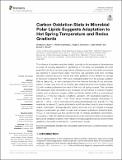Carbon oxidation state in microbial polar lipids suggests adaptation to hot spring temperature and redox gradients
Author(s)
Summons, Roger Everett
DownloadPublished version (1.833Mb)
Publisher with Creative Commons License
Publisher with Creative Commons License
Creative Commons Attribution
Terms of use
Metadata
Show full item recordAbstract
The influence of oxidation-reduction (redox) potential on the expression of biomolecules is a topic of ongoing exploration in geobiology. In this study, we investigate the novel possibility that structures and compositions of lipids produced by microbial communities are sensitive to environmental redox conditions. We extracted lipids from microbial biomass collected along the thermal and redox gradients of four alkaline hot springs in Yellowstone National Park (YNP) and investigated patterns in the average oxidation state of carbon (ZC), a metric calculated from the chemical formulae of lipid structures. Carbon in intact polar lipids (IPLs) and their alkyl chains becomes more oxidized (higher ZC) with increasing distance from each of the four hot spring sources. This coincides with decreased water temperature and increased concentrations of oxidized inorganic solutes, such as dissolved oxygen, sulfate, and nitrate. Carbon in IPLs is most reduced (lowest ZC) in the hot, reduced conditions upstream, with abundance-weighted ZC values between −1.68 and −1.56. These values increase gradually downstream to around −1.36 to −1.33 in microbial communities living between 29.0 and 38.1°C. This near-linear increase in ZC can be attributed to a shift from ether-linked to ester-linked alkyl chains, a decrease in average aliphatic carbons per chain (nC), an increase in average degree of unsaturation per chain (nUnsat), and increased cyclization in tetraether lipids. The ZC of lipid headgroups and backbones did not change significantly downstream. Expression of lipids with relatively reduced carbon under reduced conditions and oxidized lipids under oxidized conditions may indicate microbial adaptation across environmental gradients in temperature and electron donor/acceptor supply. ©2019
Date issued
2020-02Department
Massachusetts Institute of Technology. Department of Earth, Atmospheric, and Planetary SciencesJournal
Frontiers in microbiology
Publisher
Frontiers Media SA
Citation
Boyer, Grayson M., Florence Schubotz, Roger E. Summons, Jade Woods, and Everett L. Shock, "Carbon oxidation state in microbial polar lipids suggests adaptation to hot spring temperature and redox gradients." Frontiers in microbiology 11 (2020): no. 229 doi 10.3389/fmicb.2020.00229 ©2020 Author(s)
Version: Final published version
ISSN
1664-302X